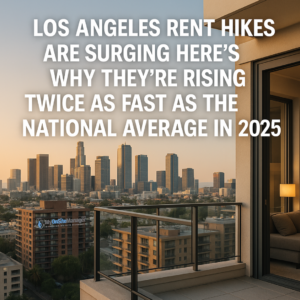Los Angeles is no stranger to high rents but 2025 has pushed the city into an even more alarming category. According to a recent report highlighted by Daily Breeze, L.A.’s rent increases are running at double the national average, widening the affordability gap and intensifying housing pressures for millions of Angelenos.
This trend isn’t just an economic data point it’s a signal of how quickly the rental landscape is shifting and what renters, landlords, and property managers need to understand moving forward.
A Growing Divide: L.A. vs. The U.S. Rental Market
Across the country, rent growth has cooled from the extremes of 2021–2022. National averages show modest, steady increases.
But Los Angeles?
It’s moving in the opposite direction.
The report shows that L.A. rent hikes are climbing at twice the speed of overall U.S. rents making the city one of the toughest places in America for renters trying to keep up.
For a city already known for its high cost of living, this widening divide raises key questions:
-
Why are rents climbing so fast here?
-
What’s driving the market pressure?
-
And most importantly what does it mean for renters and managers operating in Los Angeles?
Let’s break it down.
What’s Fueling These Rapid Rent Increases?
The L.A. rental market operates on a unique mix of economic, regulatory, and demographic forces. Several of these are converging at once, pushing rents to rise more sharply than the national average.
1. High Demand Meets Scarce Housing Supply
Los Angeles has a long-standing housing shortage. Decades of limited development, strict zoning, high construction costs, and increasing population density have created a market where demand significantly outpaces supply.
When vacancies are low, landlords have more leverage to raise prices.
2. Rising Costs for Owners: Maintenance, Insurance, Repairs
Property owners in Southern California are facing some of the highest insurance premiums and operating costs in the country especially due to wildfire risk, aging buildings, and inflation-driven maintenance expenses.
Higher costs often trickle down to tenants in the form of increased rents.
3. Slower Construction Pipeline
Even though new developments are underway, L.A.’s construction pace hasn’t been fast enough to ease pressure. Many projects are delayed by permitting, labor shortages, environmental reviews, and high construction prices.
This leaves limited new inventory, keeping competition tight.
4. Pandemic Protections Expired Creating a Catch-Up Effect
For years, L.A. had strict rent caps and eviction protections during COVID-19.
Now that many of these protections have expired, some landlords are raising rents more aggressively to “catch up” after several years of limited increases.
5. Migration Patterns Are Shifting
Despite stories of people moving out of California, L.A. still attracts high-income earners, remote workers, and industry professionals. This influx keeps competition alive in certain neighborhoods, driving up average rent prices.
Why This Matters: Major Impacts on Renters and the Housing Market
The rapid rise in rents has real consequences not just for tenants, but for the broader housing ecosystem.
For Renters:
-
Affordability challenges intensify
-
Higher rent burdens push many to consider relocating
-
More households double up, increasing overcrowding
-
Savings and disposable income shrink
-
Displacement risks rise in vulnerable communities
For Property Managers and Owners:
-
Higher turnover if tenants can’t absorb increases
-
Increased scrutiny from tenant advocates and policymakers
-
Greater pressure to justify rent adjustments
-
Potential reputation risk if increases are perceived as excessive
-
Possible regulatory changes if rent hikes continue at this pace
A fast-growing market can be profitable, but it also requires responsible management and proactive communication to maintain long-term stability.
What Property Managers Should Be Doing Right Now
With L.A.’s rental market heating up faster than the national average, property managers and landlords need to stay ahead of the curve.
1. Reassess Renewal Strategies
Consider gradual increases instead of sharp jumps to improve tenant retention.
2. Maintain Transparent Communication
Explain cost increases and value improvements. Tenants respond better when they understand why rents are rising.
3. Implement Preventive Maintenance
Reduce long-term costs by staying ahead of major repairs especially in L.A.’s aging buildings.
4. Benchmark Regularly
Compare your rent levels with nearby properties to stay competitive and avoid pricing yourself out of the market.
5. Monitor Legislative Updates
L.A. is known for strong tenant protections. More regulations could be proposed if rent hikes continue. Staying compliant protects both your residents and your business.
Looking Ahead: What’s Next for Los Angeles Renters?
Unless construction accelerates and affordability initiatives expand, rent pressures are likely to remain elevated.
Los Angeles may continue to outpace national trends not because it wants to, but because market conditions and local infrastructure challenges leave little room for relief.
For renters, it’s a difficult moment.
For property owners and managers, it’s a call to balance sustainability with compassion.
And for the housing market as a whole, it’s a reminder that without strategic change, affordability challenges will only deepen.

